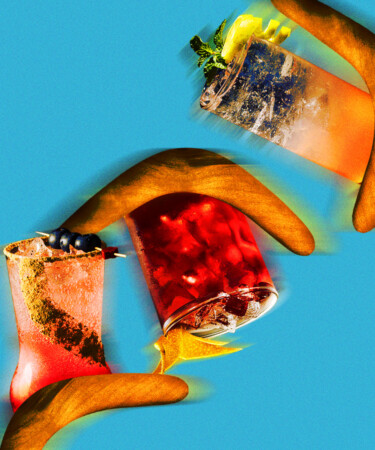Like any gig, bartending has its pros and cons. On one hand, bartenders get to meet new people every day, craft cocktails, and discover new spirits. On the other hand, it’s a job marked by long weekend shifts, being tethered to “the stick” for hours at a time, and physical pains ranging from thrown-out shoulders to sore feet.
Beyond these pitfalls, arguably one of the biggest downsides of bartending is the toll it can take on a person’s social life. Despite being a front-facing hospitality gig, most bartenders work at the same time as their industry friends, meaning they rarely get to visit each other at their respective bars. But bartenders are a creative bunch prone to out-of-the-box thinking. And while they haven’t hacked a way to hang out with each other mid-shift, they’ve developed a method to let their peers know that they love them. We’re not talking blowing kisses across the street. We’re talking about “Boomerangs.”
As industry vet Jeffrey Morgenthaler writes in “The Oxford Companion to Spirits & Cocktails,” “a Boomerang is a drink sent by the bartender at one bar to the bartender at another. The drink is typically served in a glass covered in cling wrap, and often placed in a to-go food container for the sake of stealth. This clandestine and largely illegal practice has probably existed for some time but gained notoriety in the late 2000s thanks to the cocktail community in New York City’s East Village.”
To better understand the ins and outs of Boomerangs — and how these exchanges go down — we consulted with a bartender who’s worked in the East Village for over a decade. Since sending free alcoholic drinks covered with plastic wrap between bars is illegal, they asked to remain anonymous.
Contrary to our initial instincts, Boomerangs aren’t about R&D or testing new cocktail ideas. As our source explains, “They’re simply a way to show love to the team at another bar. They can range from a well-thought-out Milk Punch all the way to Jameson and pickle juice.”
As for the name “Boomerang,” it doesn’t imply any obligation to return the favor. It’s more of a symbol of mutual respect. “It’s called a boomerang because what goes around comes around,” our source says. “But that doesn’t imply an obligation. It more so refers to goodwill between bars.”
The trickiest part of Boomerang culture is figuring out how to get the drink from point A to point B without anyone getting in trouble. Since the practice is illegal, the sender needs to package and disguise the drink with care.
“Packaging ranges, but the key is to make sure that it isn’t going to spill. It’s also nice to let the team know what’s in it due to allergies,” our source says. “I think the craziest one I’ve received was in a bodega coffee cup capped with labeling tape.”
It’s not just about how a bartender conceals a Boomerang; the more crucial part is finding someone trustworthy to transport one without raising alarms. According to our source, if a guest volunteers to be a courier, that’s usually a red flag.
“You usually send it with a guest that you got along with or a friend — someone that passes the vibe check,” our source says. “It’s also a way to give a guest a sort of wink and get them involved in a fun gimmick, but it has to happen organically.”
As Morgenthaler mentions in “The Oxford Companion,” nobody really knows where Boomerang culture began, but it’s undeniably an aspect of the NYC bar scene. “I certainly hadn’t experienced it before I moved to New York,” our source says. “The first time I got one, it was a very fun surprise and made me love the industry here all the more.”
We’re not here to encourage illegal activity, but to anyone on the receiving end of a Boomerang during a shift, consider it a blessing and know that a nearby bartender is sending some love. Just be sure to celebrate quietly. You never know who’s listening.
*Image retrieved from VAKSMANV via stock.adobe.com
